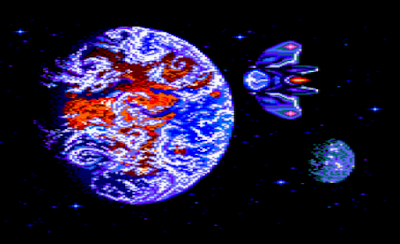From The CRPG Addict
Date Ended: 9 December 2018
Ranking at Time of Posting: (to come later)
Like most French games of the era, including Ubisoft’s prior two titles (Fer & Flamme et L’Anneau de Zengara), Le Maître des Âmes (“The Master of Souls”) offers a sense of the bizarre that goes beyond the simple fact that it’s in a foreign language. French RPGs of the 1980s feature weird combinations of plot elements from mythology, fantasy, and sci-fi, NPC dialogue that makes little sense even in its original language, vague quests, and odd in-game asides. It’s as if their developers felt that RPGs were the next frontier for the Surrealist movement. Like the British ZX Spectrum games from the same era, they stand out for their originality in game elements and interfaces. In contrast to Germany, where RPG development was immediately influenced by The Bard’s Tale and a few other U.S. titles, France built everything from scratch. More often than not, I hasten to add, the results were weird and unsatisfying rather than praiseworthy, but at least I never look at a French RPG and say “this again?!”
 |
| Part of the in-game backstory. |
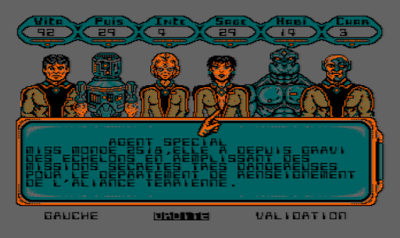 |
| Selecting the class after the attribute roll. |
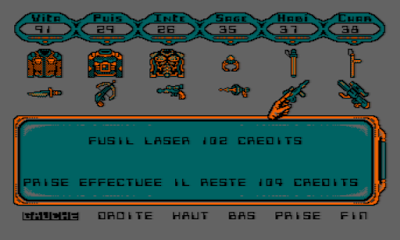 |
| Selecting equipment. I’m not sure what the bracelets do. |
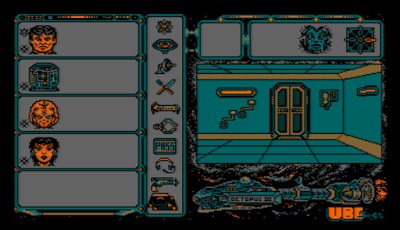 |
| The game begins! |
 |
| The different sections of the game. |
Enemies are unnamed. They’re mostly bestial, with the suggestion that the research station was doing experiments on aliens and they escaped. There are giant toads, insect creatures, monstrous plants (looking like Audrey II from Little Shop of Horrors), lizardmen, and aliens that look a lot like orcs repurposed from Le Maître des Âmes II. When you enter combat, you just keep hitting “attack enemy” until someone dies. Enemies never drop anything; the primary reason to fight them is that they’re standing in your way. Sometimes you can blow past them if you’re fast, but rarely can you say, enter a room with an enemy, pick up the valuable item in the room, and get out.
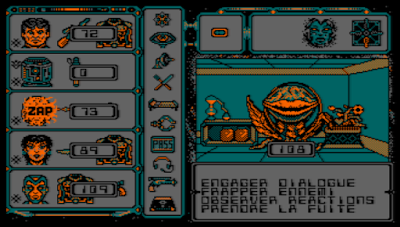 |
| “I’m just a mean green mother from outer space, and I’m bad.” |
There are 11 NPCs in the game, four of whom will join the party. You have to be careful because you need some of the NPCs (or their items) in particular places, but once they’re replaced by other NPCs, they never appear again. The NPCs include:
- Three “dialogue robots” who tell you things about the station.
 |
| The first hint that the “big bad” is a black stone. |
- A giant insect named Crapounick of the Pabo species. He was a prisoner on the station who fled in the confusion.
- An unnamed researcher who just woke up from hibernation and doesn’t know what’s going on. He will join the party.
- Leonihr, ambassador from the Titus Nebula, who took refuge on this ship when her shuttle crashed.
- Tel, a telepathic blob from Gloubi.
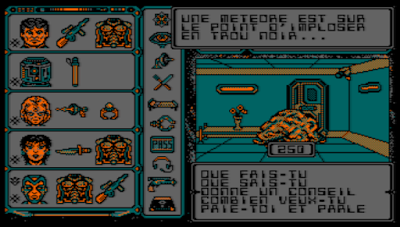 |
| Here he is, looking like a Spemin. |
- Imos, son of Xeron from System Ega. His system was absorbed by a black hole, and he has come seeking revenge. He will join the party, and he has a security pass necessary for the final door.
- Hathy-Hen, a G.I.G. agent hiding from pirates. He has a shield that provides protection against the titular Absolute Master and he will join the party.
- A maintenance robot who helps to repair the central computer.
Dialogue with each of the NPCs is through a series of questions: “Identify yourself”; “Who sent you?”; “What are you doing?”; “What do you know?”; and “Give some advice.” Some NPCs demand credits for the advice.
Through these dialogues, it becomes clear that the Absolute Master is some kind of black crystal named Tinaus. Tinaus is somehow capable of generating black holes and thus swallowing worlds. It wanders through space until it finds a system to victimize. It has lately attached itself to the Octopus III and is slowly destroying it. This is represented by some fun graphics that show cracks and holes in the bulkheads of some sections, as well as a number of doors that simply open to space and kill the party instantly. You want to save a lot.
 |
| The master computer warns me that Tinaus is destroying the Octopus III. |
 |
| The party accidentally spaces themselves by opening a door. |
Incidentally, full party death is accompanied by a neat visual:
 |
| I guess that’s a black hole sucking up the Earth’s crust. So maybe not so “neat.” |
The last sightings were terrifying. Octopus seemed to draw around it a fog of whirling matter. Suddenly, in an infernal ballet, the Earth left its orbit to go towards this whirpool that had become the ship. It took no more than an hour for the globe to be digested, and less than a week for the solar system to disappear forever.
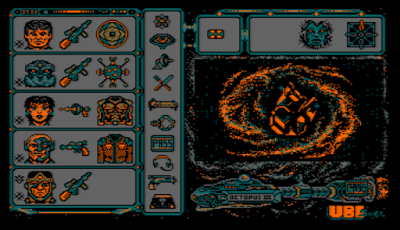 |
| Very few games bring you face-to-face with a giant space crystal. |
This black crystal was indeed the most strange and hostile spacial phenomenon that humanity had the chance to encounter. Traveling for millennia in the form of a common pebble, this titanic life suddenly awoke with a hunger colossal when it created around it a tornado of matter, aspiring galaxies, before returning to its dreams macabre.
A winning game takes less than an hour once you know what you’re doing. After my first party was depleted exploring the base, I rolled a second party of tougher characters (I didn’t need any robot to talk to other robots since I already knew the dialogue) and won it with them.
Miscellaneous notes:
- There is no sound in the game.
- It’s tough to tell which items are interactable and which aren’t. Every room has panels, telephones, sinks, and other decorations that look like you should be able to do something with them, but you can’t.
 |
| None of this is interactable. |
- A lot of the rooms are dark and require a character with a flashlight to navigate.
- Some of the characters come with special abilities, but I didn’t really find any use for them.
The game doesn’t GIMLET well. Character creation is very limited, and there’s hardly any development. Combat involves mashing a button and hoping for the best. There are few equipment rewards after character creation, and the only “economy” is bribing people with your leftovers. It does best in the overall story and NPCs (3s), but even they’re not very good. The final score comes to 19, quite a bit lower than the 30 I gave to Le Maître des Âmes, which was longer and more satisfying although still possessed of many of the same issues.
Le Maître Absolu has a couple of features that I’ve come to associate with French games, and Ubisoft’s early titles specifically. First, it features a party that degrades throughout the adventure. Most RPG parties start weak and get stronger through character development, their hit points replenishing through healing potions and spells. With this game, and a few others like it, the characters are strongest at the beginning. Their pool of hit points is expected to to last the entire adventure and never really gets replenished. Food and sleep staunch the bleeding but don’t really restore much.
Second, the plot seems cobbled together from various fictional sources. I don’t know what they are and don’t know for sure that this is the case, but it feels like a mélange of characters and themes rather than something created specifically for this game, much in the way that Ubisoft’s L’Anneau de Zengara was based on a variety of Conan stories and the themes of Tera: La Cité des Crânes came from the novels of Michael Moorcock and other British sci-fi authors. Perhaps my readers will find something familiar in the plot and proper names described above. It certainly doesn’t make much sense that a crystal capable of creating black holes is called “the absolute master.”
This was the last (known) game from the minds of Eric Doireau and Christophe Le Scoarnec. (Other than the two Maitres, they worked on a 1988 erotic game called Teenage Queen.) Doireau may have become a sculptor; at least, there is a relatively well-known sculptor of that name and approximately the right age.
1989 was really the last year of the âge d’or of uniquely French RPGs, which started in 1985 with Mandragore and continued with titles like Fer & Flamme (1986), Les Templiers d’Orven (1986), Tera (1986), Inquisitor: Shade of Swords (1987), and the two Maitres. (I still have to check out 1986’s Omega: Planete Invisible and Sapiens.) French developers made RPGs after this, of course, but they lose a lot of their outré characteristics in favor of a more conventional western RPG experience. Those will rate higher, but they’ll never be quite as interesting as the batch we saw in the late 1980s.
Original URL: http://crpgaddict.blogspot.com/2018/12/game-310-le-maitre-absolu-1989.html


